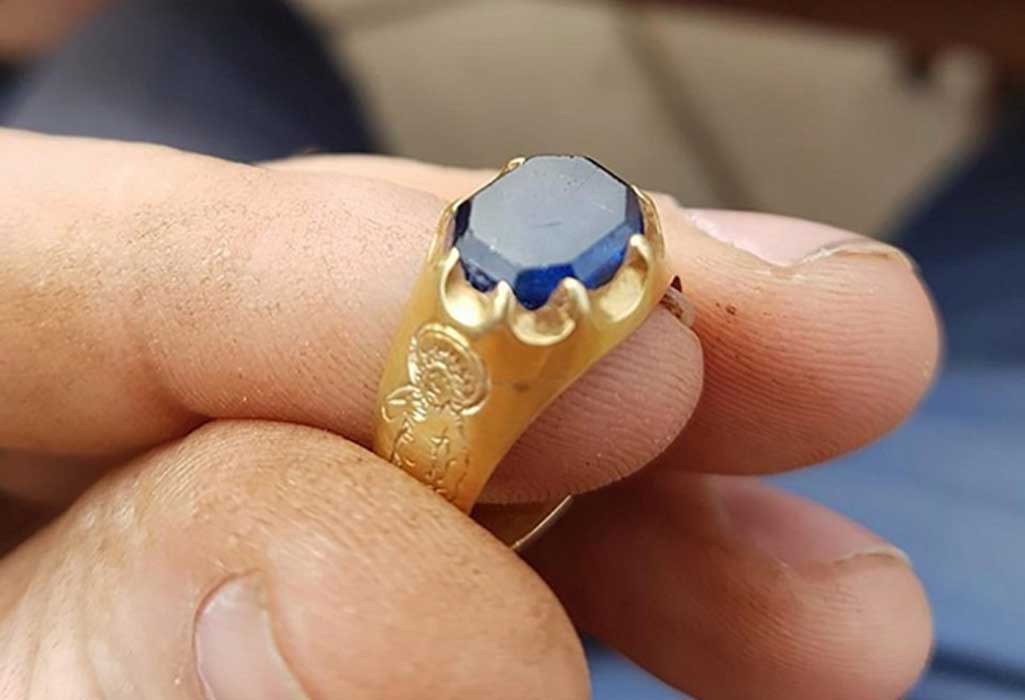Medieval Ring Found in Robin Hood’s Forest May Net a Small Fortune
In 2016, an amateur treasure hunter with a metal detector turned up a medieval gold ring that was set with a sapphire stone in Sherwood Forest—haunt of the legendary (or real) Robin Hood. Experts have examined the ring and believe it may date to the 14th century. The most exciting news for the ring’s finder is that experts believe it may fetch $64,500 in an upcoming auction.
Discovering a Treasure in Sherwood Forest
The amateur, Mark Thompson, found the treasure when he was using an inexpensive detector that he bought on the online auction website Ebay. He is a painter of fork-lifts and had been searching for treasure for just a year and a half, said the Daily Mail .
He detected metal underneath his wand just 20 minutes into his session in Sherwood Forest in Nottinghamshire.
- Rogue Metal Detectorists On Trial For Stealing $3.6million Treasure
- Metal Detectorists Discover Stash of 550 Ancient Coins Worth £150,000
- Detectorist Finds Falsely Executed 17th-Century Courtier’s Gold Signet Ring

The medieval gold ring. (Mark Thompson photo)
Online news accounts of the find said Mr. Thompson expected to find scrap metal of no value or coins of little value, but when he turned up the soil he saw the glint of gold.
One side of the ring depicts a baby, believed to represent the Christ child, and the other side depicts a female saint, probably Saint Elizabeth of Hungary. Both figures are engraved into the gold of the ring. Mr. Thompson reported the find to proper authorities.
“I called my friend who came down to take a look and help see whether there was anything else related nearby,” Thompson told British news outlets in 2016. “If it does prove to be as valuable as we think it might be, it would completely change my life. I’m renting at the moment and I’d love to be able to buy a house or move into somewhere more comfortable.”
The Value of the Medieval Gold Ring
The ring may net him a small fortune if it truly is worth its estimated value of $64,500, as given by an expert at the British Museum. The auctioneers, Christie's of London, have given the ring a more conservative estimate of approximately $45,000. Either way, the profit will have to be split 50/50 with the landowner. A spokesperson for Christie's has explained the value and meaning behind the ring, stating:
“A sapphire of this size and quality is highly unusual in jewels of this period. Prized for its intrinsic value, beauty and rarity, the sapphire was believed to keep the wearer from poverty. It is also the colour of the Virgin and of the heavens, which meant it would have protected the wearer's chastity, comforted the heart, expelled envy and detected fraud and witchcraft. This ring is also engraved on the shoulders with depictions of the infant Christ and of St. Elizabeth of Hungary evoking the age of faith, epitomising the late medieval world.”

“The sapphire was believed to keep the wearer from poverty.” (Sapphiredge/CC BY SA 3.0)
A regional finds liaison officer, Dot Boughton, has written a report, according to the Sun, that compares the stone to another that adorns the tomb of William Wylesey, who died in 1374 and who was the archbishop of Canterbury.
Mr. Thompson had to wait for three years to get the chance to put the medieval gold ring up for auction. That time was spent following proper legal procedure for when someone discovers buried treasure and to have the ring identified and valued with the British Museum and a coroner. The coroner declared the ring a treasure, which gave the museum the first opportunity to buy it. When they declined, the ring was returned to Mr. Thompson, who has now decided to auction it off.
The Kind of Loot Robin Hood Would Like…
The ring is not believed to be contemporaneous with Robin Hood, who, according to legend, operated with his gang out of Sherwood Forest in the 13th century, around the time of King John. It is unknown who Robin Hood truly was or even if he was more than just a legend but a real historical figure.
- Metal detectorist uncovers Roman treasure hoard in England
- Grandmother May Have Found a Ring Owned by Shakespeare
- Bluetooth Treasure: Metal Detector Dings on Silver of the Danish King in Germany

A statue of Robin Hood. (Pixabay License)
He differs from other robbers of the time, including Fulk Fitzwarin and Eustace the Monk, who were real people and not just legendary. Legends say Robin Hood stole from the rich and gave to the poor.
One thing all three of these robbers and other fugitives have in common was that they used the king’s private forest reserves for refuge. The forests of Sherwood and Barnsdale, which are rife with old legends, were supposed to have been the kings’ private lands where they could hunt.
Historians think there may have been two historical figures from whom the legend of Robin Hood derives. Other outlaws also possibly took the name, which further confuses the historical record.
Top Image: Experts have valued the medieval gold ring between $45,000 and $64,500. Source: Mark Thompson photo
By Mark Miller




















Comments
An extraordinarily beautiful ring. A few years back I attended a lecture by archaeologist, Mark Olly who gave a persuasive and engaging presentation on the historical reality of Robin Hood. Be nice to see him providing content on Ancient Origins.
http://www.wilmslowguild.org/about-us/tutors/mark-olly/
Shouldn't he own the ring outright and not just get a "reward"?
Thanks for the link… enjoyed the clip.
The British TV show Time Team did an interesting analysis of possible historical sources for the Robin Hood legends.
https://youtu.be/2yQ38lu-M3w